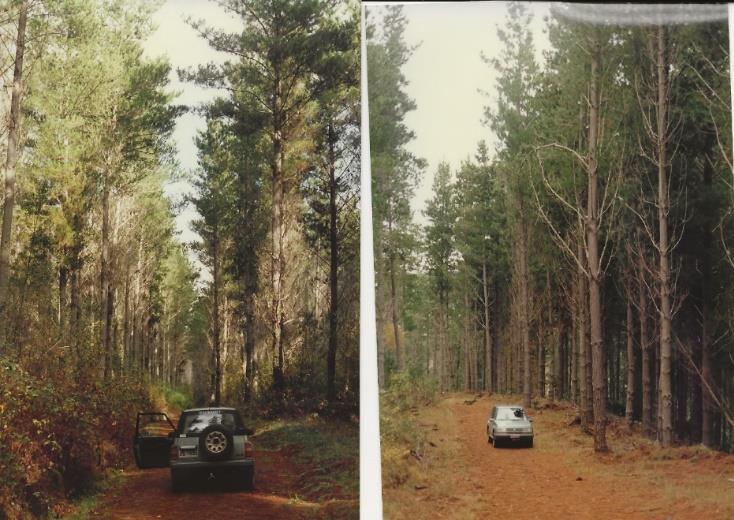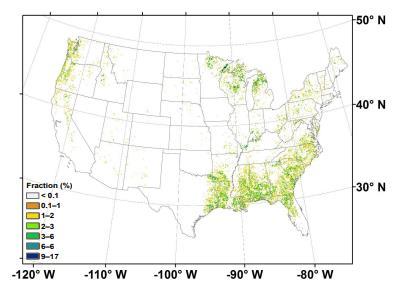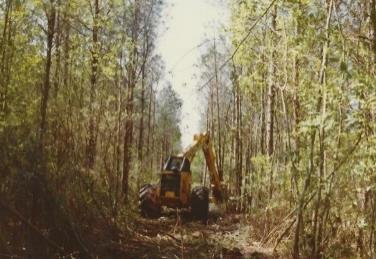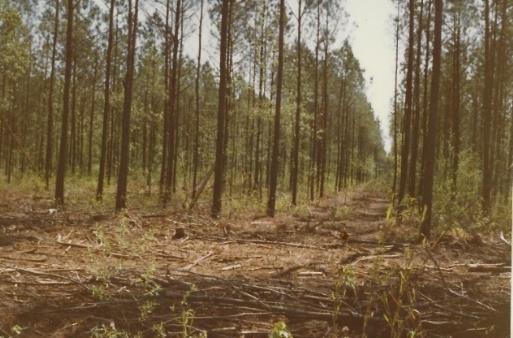
3 minute read
USA
from PNGAF MAGAZINE ISSUE # 9D4D of 15th March 2022 - global timeline forest tree plantations
by rbmccarthy
Forestal Valdivia Chile. Left 23 yr. old Plantation P. radiata. Right 19 yr. stand P. radiata. Thinned using oxen to 450s/ha. Photo credit Dick McCarthy Gottstein fellowship 1992
USA Plantation Forests Period 2000–2004.
Advertisement

Source: Earth Syst. Sci. Data, 9, 545–556, 2017
In the USA, forest plantings in the southern states from the 1930’s with Pinus spp as loblolly pine. P. taeda and slash pine P. elliottii.


Mechanised fifth row out row thinning with selection thinning of remaining four rows. Photo credit Dick McCarthy USA/Canada APMF study tour 1982.
The main plantations in tropical America prior to 1950, were on a small scale for fuelwood, railway sleepers and mine pit props.
The development of Australia’s plantation estate has gone through a series of phases over the past 110 plus years. Motivated by a need for softwood timber and import replacement, radiata pine was the species of choice for the early plantations in temperate eastern Australia and in Western Australia Maritime pine was also planted, demonstrating a pragmatic approach to species selection. In northern east coast Australia, more suitable species of softwood were planted including A. cunninghamii (Hoop pine - a local species), Caribbean pine and Slash
pine. There was less motivation to develop hardwood species plantations given the available natural forest resources.
Two further points should be noted for this period.
First, the great bulk of tree planting was carried out by the state as a specific tool of forest policy. In many countries this was afforestation of bare land, e.g., in the UK, or conversion of what was deemed unproductive native forest, e.g., pines (P. radiata) replacing eucalypt woodland in Australia (Turner et al., 1999).
The second point is the raising of serious doubts about the sustainability of plantation silviculture in the very country, Germany, where it had been so successful. Many second and third rotation spruce (P. abies) plantations, particularly in Saxony, were showing declining yields and other signs of ill-health, which were attributed to the effects of the clear-cutting and replanting silvicultural system (Weidemann32, 1923).
There was considerable alarm and attacks on the concept of planted forests (Anon., 1923), and specifically that of conifer monoculture (Stickel33, 1928), though many felt it was more to do with planting spruce (P. abies) ‘off site’ in the first place: the issues were never fully resolved (Evans34, 1976). Similar concerns re-surfaced in Australia in the 1960s.
Three post-war trends can be identified for this period, which bear on the development, including expansion, of planted forests. After the Second World War many new international agencies arose, including the UN FAO, which have had an important influence on forest policy and development. But, in addition to their general stimulus through provision of funds, development aid and technical expertise, substantial direct investment in industrial plantations also began. For example, both the major plantation projects in Swaziland date back to this period and were funded mainly by private companies with some institutional backing (Evans and Wright351988).
Declining colonial influence and the newly emerging independent states after the Second World War altered economic and developmental pressures in many tropical countries. Development became a politically important process: the key to meeting the people’s aspirations in the new countries. Development of forest plantations can claim no great part in aid programmes of this period, but in several countries tree planting increased substantially as part of the overall development process. And, as King36 (1975) pointed out, almost every
32Weidemann, E. 1923. Zuwachsrückgang und Wuchstockungen der Fichte in den mittleren und den unteren Höhenlagen der Sächsischen Staatsforsten. Tharandt. (Translation No 302, USDA, C.P. Blumenthal, 1936) 33 Stickel P (1928) Comparative Forest Fire Hazard in the Northeast. Journal of Forestry, Volume 26, Issue 4, April 1928, Pages 456–463, https://doi.org/10.1093/jof/26.4.456 34 Evans J (1976) Plantations: Productivity and Prospects. https://doi.org/10.1080/00049158.1976.10674148 35 Evans J and Wright D (1988) Symposium on Forest Tree Breeding, 15 th International Congress on ... South African Forestry Journal 96, 23-6. 36 K.F.S. King (1975) It’s time to make paper in the tropics. Address to the American Paper Institute's Pulp, Fibre and Raw Materials Group meeting in New York. Unasylva Vol 27 (3) 1975.








